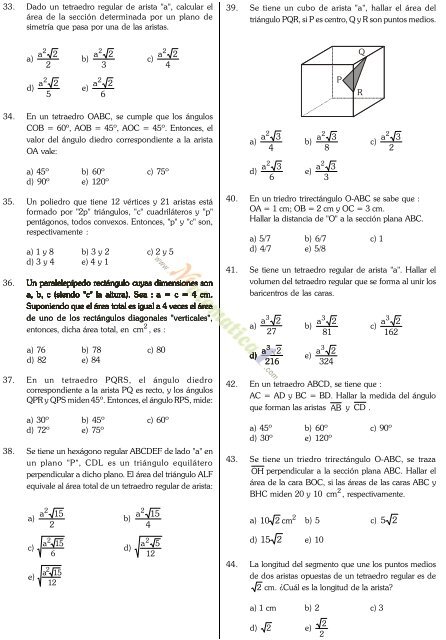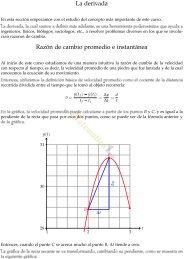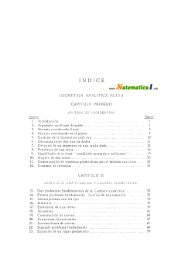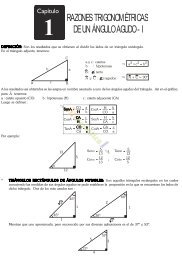libro de geometria preuniversitaria nivel uni click aqui para ver
libro de geometria preuniversitaria nivel uni click aqui para ver
libro de geometria preuniversitaria nivel uni click aqui para ver
Create successful ePaper yourself
Turn your PDF publications into a flip-book with our unique Google optimized e-Paper software.
33. Dado un tetraedro regular <strong>de</strong> arista "a", calcular el<br />
área <strong>de</strong> la sección <strong>de</strong>terminada por un plano <strong>de</strong><br />
simetría que pasa por una <strong>de</strong> las aristas.<br />
a)<br />
d)<br />
a 2<br />
2<br />
2<br />
a 2<br />
5<br />
2<br />
b)<br />
e)<br />
a 2<br />
3<br />
2<br />
a 2<br />
6<br />
2<br />
c)<br />
a 2<br />
2<br />
4<br />
34. En un tetraedro OABC, se cumple que los ángulos<br />
COB = 60º, AOB = 45º, AOC = 45º. Entonces, el<br />
valor <strong>de</strong>l ángulo diedro correspondiente a la arista<br />
OA vale:<br />
a) 45º b) 60º c) 75º<br />
d) 90º e) 120º<br />
35. Un poliedro que tiene 12 vértices y 21 aristas está<br />
formado por "2p" triángulos, "c" cuadriláteros y "p"<br />
pentágonos, todos convexos. Entonces, "p" y "c" son,<br />
respectivamente :<br />
a) 1 y 8 b) 3 y 2 c) 2 y 5<br />
d) 3 y 4 e) 4 y 1<br />
36. Un <strong>para</strong>lelepípedo rectángulo cuyas dimensiones son<br />
a, b, c (siendo "c" la altura). Sea : a = c = 4 cm.<br />
Suponiendo que el área total es igual a 4 veces el área<br />
<strong>de</strong> uno <strong>de</strong> los rectángulos diagonales "<strong>ver</strong>ticales",<br />
2<br />
entonces, dicha área total, en cm , es :<br />
a) 76 b) 78 c) 80<br />
d) 82 e) 84<br />
37. En un tetraedro PQRS, el ángulo diedro<br />
correspondiente a la arista PQ es recto, y los ángulos<br />
QPR y QPS mi<strong>de</strong>n 45º. Entonces, el ángulo RPS, mi<strong>de</strong>:<br />
a) 30º b) 45º c) 60º<br />
d) 72º e) 75º<br />
38. Se tiene un hexágono regular ABCDEF <strong>de</strong> lado "a" en<br />
un plano "P", CDL es un triángulo equilátero<br />
perpendicular a dicho plano. El área <strong>de</strong>l triángulo ALF<br />
equivale al área total <strong>de</strong> un tetraedro regular <strong>de</strong> arista:<br />
a)<br />
c)<br />
e)<br />
a 15<br />
2<br />
2<br />
a 15<br />
6<br />
2<br />
a 15<br />
12<br />
2<br />
b)<br />
d)<br />
a 15<br />
4<br />
2<br />
a 5<br />
12<br />
2<br />
39. Se tiene un cubo <strong>de</strong> arista "a", hallar el área <strong>de</strong>l<br />
triángulo PQR, si P es centro, Q y R son puntos medios.<br />
a)<br />
d)<br />
a 2<br />
a 2<br />
3<br />
4<br />
3<br />
6<br />
b)<br />
e)<br />
a 2<br />
3<br />
8<br />
a 3<br />
3<br />
2<br />
P<br />
Q<br />
R<br />
c)<br />
a 3<br />
2<br />
2<br />
40. En un triedro trirectángulo O-ABC se sabe que :<br />
OA = 1 cm; OB = 2 cm y OC = 3 cm.<br />
Hallar la distancia <strong>de</strong> "O" a la sección plana ABC.<br />
a) 5/7 b) 6/7 c) 1<br />
d) 4/7 e) 5/8<br />
41. Se tiene un tetraedro regular <strong>de</strong> arista "a". Hallar el<br />
volumen <strong>de</strong>l tetraedro regular que se forma al <strong>uni</strong>r los<br />
baricentros <strong>de</strong> las caras.<br />
a)<br />
a 2<br />
27<br />
3<br />
a 2<br />
d)<br />
216<br />
3<br />
a<br />
d)<br />
216<br />
3<br />
a<br />
d)<br />
216<br />
3<br />
d)<br />
b)<br />
a 2<br />
81<br />
3<br />
a 2<br />
e)<br />
324<br />
3<br />
a 2<br />
c)<br />
162<br />
3<br />
42. En un tetraedro ABCD, se tiene que :<br />
AC = AD y BC = BD. Hallar la medida <strong>de</strong>l ángulo<br />
que forman las aristas AB y CD .<br />
a) 45º b) 60º c) 90º<br />
d) 30º e) 120º<br />
43. Se tiene un triedro trirectángulo O-ABC, se traza<br />
OH perpendicular a la sección plana ABC. Hallar el<br />
área <strong>de</strong> la cara BOC, si las áreas <strong>de</strong> las caras ABC y<br />
2<br />
BHC mi<strong>de</strong>n 20 y 10 cm , respectivamente.<br />
2<br />
a) 10 2 cm b) 5 c) 5 2<br />
d) 15 2 e) 10<br />
44. La longitud <strong>de</strong>l segmento que une los puntos medios<br />
<strong>de</strong> dos aristas opuestas <strong>de</strong> un tetraedro regular es <strong>de</strong><br />
2 cm. ¿Cuál es la longitud <strong>de</strong> la arista?<br />
a) 1 cm b) 2 c) 3<br />
2<br />
d) 2 e)<br />
2







